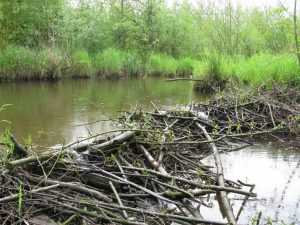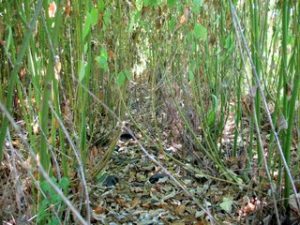You awaken to the grey light and rustling of camp. The rain stopped at dawn but branches are still dripping. The morning cooks are in the outdoor kitchen stirring oatmeal and turning skewers of venison from a hunting party last weekend. There are still huckleberries in the meadow. The morning is cold but bright—the fog will break.

Beaver ponds once held the rain in lowland stream corridors. Bundles of cuttings we cut yesterday are soaking in the swamp, and we decided at last night’s fire to stake another section of the old field this morning. If we grow enough forage, the beaver will have the materials to expand their ponds. The ponds push water into the earth keeping the creek flowing cold in summer, even with the heat and drought. After breakfast we stretch while walking to the meadow stay warm. You teach a new arrival how to identify the leafless twigs, and we stop at an two-year-old planting to see how they’ll grow. We talk about the future as we work.
Our second group will stay at camp to build a sleeping platform along the narrow trails that wind through the old clear-cut, now developed with berries and sleeping nooks. We’re expecting a large group over the weekend. We’ll need two boxes of vegetables from the farmers down valley. All that’s left for wild greens are the shattered seed heads and fall germinants. It’s the end of the growing season and you can feel camp season winding down.
The conservation district signed up as guests for lunch. A couple landowners want help planting forest around their reach of the creek, like the forest gardens around camp. They don’t want government contracts, but they are trusted in the valley. We’ll prepare the site together next summer and plant next rainy season. They’ll add nut trees and we fill it out with cuttings, seeds, and divisions. The designs are already posted on the wiki by last week’s clerk, a guild-member passing through from the wet prairies of the upper Willamette.

After cold lunch with hot tea, you join a study group talking over a chapter on wetland hydrology in a warm corner of the dome. Some are students from the college that have been measuring groundwater in key tributaries to the creek. Another group is taking the break in the rain to ride bikes down the valley. A new guild-member has a black locust grove that could better grow fence posts if managed as a coppice. He wants to plant nettles and huckleberries in his streamside forest. When the weekend guild-members arrive we are expecting a chainsaw team, and the locust grove can provide next year’s fuel.
Dinner comes together well tonight. There’s a long timer that loves fire cooking sorting fuel and you’re happy washing dishes, ever since the heat exchange below the fire pit now heats wash water. The wildcrafters from Island Camp have been picking oyster mushrooms in the alder and planting spawn. The tribe is selling early return from the hatchery. Dinner will be a fish and mushroom stew with barely and biscuits. A farmer and guild-member down the valley has been experimenting with grains suited to our rainforest climate. Each ingredient reflects a relationship with the forest, the water, or our neighbors.
Only tree planters will stay into the dark wet season, joined by guild-members with small projects wanting quiet away from the city. The tree planters will move up and down the valley among mulch piles scythed and piled in anticipation of this planting season. There are thousands of oak and cedar coming from the nurseries. It will be tree planting, or we’ll help fish counting crews map salmon redds. There are new riffles in the stream where a chainsaw team dropped some trees in the creek. The stream scoured new holes and laid sorted beds of gravel like the coho spawners are looking for. Based on counts three years back we hope for a strong return even with troubled ocean conditions.
Since the watershed district formed, more in the community are catching the rain. We store rain for aquaculture and crops, or push it into groundwater for fish, like the old forests used to do. The stored rain keeps floods from scouring the salmon eggs over winter, and irrigates upland fields, which has let us turn some bottom lands into beaver swamps, that once again serve yearling salmon and migrating ducks. Some of the new wetlands are designed to provide fodder and bedding. Others coddle patches of odd crops pulled from ethnobotany books and served in fancy urban restaurants: tender greens, cattail shoots and wapato.
Some guild-members stop for the night on their way back from a music festival with a fiddle and pipes and get the leftovers. They’ll work some in the morning and move on. A few clouds scuttle overhead. As you drift to sleep, content and tired, the rain starts up again in earnest, to trickle through the moss and saturate the land again.


